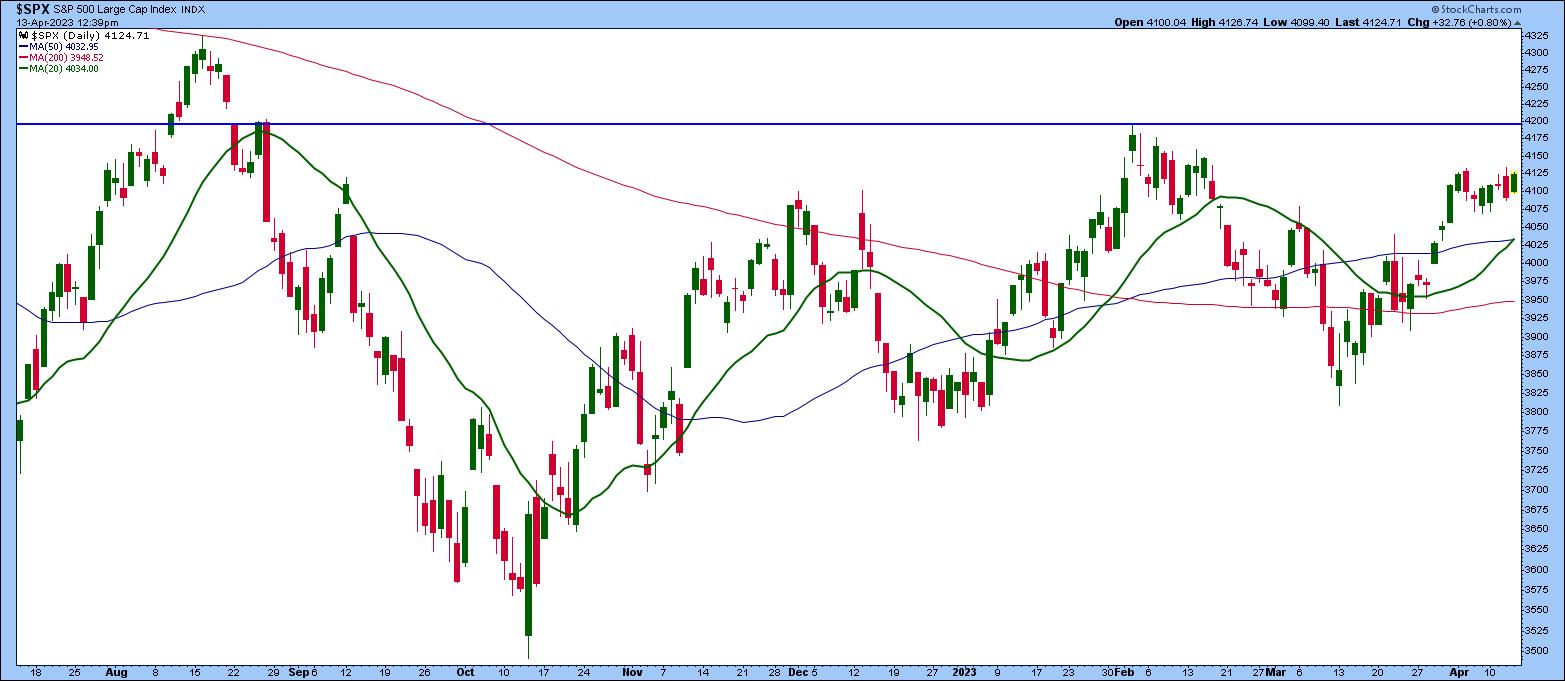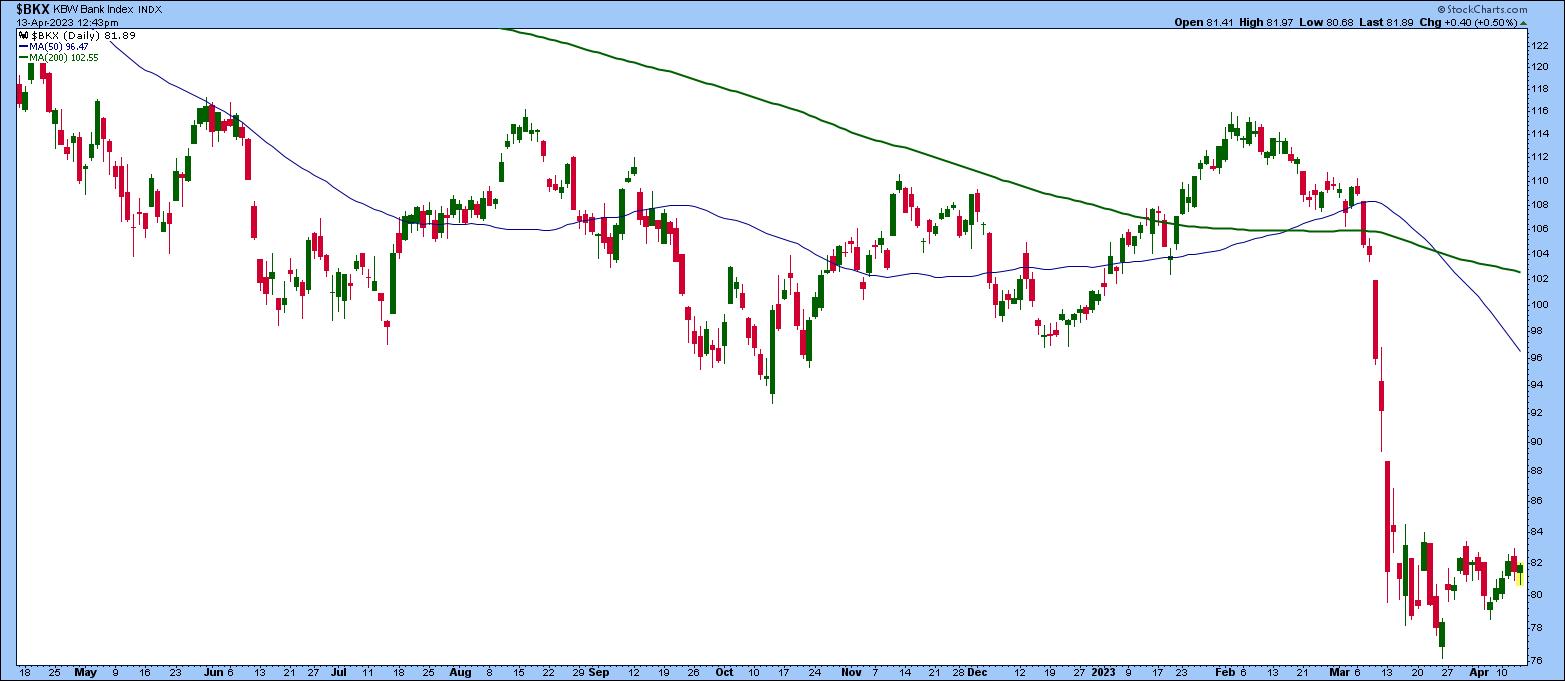
It's all about inflation and earnings. Will the Fed continue to raise interest rates after two key gauges of prices came in lower than estimates? After the recent regional bank fallout, will bank earnings be strong enough to lift the Financial sector out of its doldrums?
The government's March consumer price index (CPI) came in lower than estimated—headline CPI rose 0.1% in March, which was less than the 0.2% Dow Jones estimate. And if you look at year-over-year numbers, it was up 5% vs. the 5.1% estimated. Core CPI (ex-food and energy) rose 0.4% and 5.6% annually. Both numbers were in line with expectations.
The March producer price index, aka PPI, dropped by 0.5% compared to the previous month. Remember, PPI tells us how much manufacturers are paying for their materials on their end. If costs increase, it's generally transferred to the end products, meaning higher consumer prices.
Overall, economists thought the PPI would stay the same as last month, so the decline seems promising. Taking out food and energy, core wholesale prices decreased by 0.1% from last month. That's way better than the 0.2% increase economists were predicting.
Year over year, the PPI is up 2.7%, whereas last month's reading was 4.6%. Minus food and energy prices, core PPI is up 3.4% as compared to last month, where core PPI was up 4.4%.
Signs of Softening Labor Market
Jobless claims came in at 239,000, when 235,000 had been expected. This may give the stock market a boost. This latest figure shows that jobless claims are at their highest level in over a year. It's still pretty low overall, though. As you know, the Fed has been trying to cool down the economy and the job market to fight inflation, but the jobs market hasn't been hugely affected yet.
Unemployment benefit applications reflect the broader trend of layoffs. And as far as the current round goes, many of the big Tech companies that aggressively hired during the pandemic continue to shed headcount. Amazon (AMZN), Facebook (META), IBM (IBM), Microsoft (MSFT), Salesforce (CRM), and DoorDash (DASH) have all initiated job cuts, some as early as last November.
Still, there's more softening to come. US employers added 236,000 jobs in March. This suggests the economy is still relatively growing, despite the nine rate hikes the Fed implemented over the past year to ease inflation.
The unemployment rate is currently at 3.5%, but the Fed predicts it may rise to 4.5% by the end of the year. Note that this kind of increase is sizable, and, if you look at it historically, it tends to be associated with recessions. Additionally, the Labor Department reported that US job openings sunk in February down to 9.9 million. That's the lowest since May 2021.
What's the Economic Data Indicating?
When you combine PPI with the March CPI report released on Wednesday, it seems inflation is easing up a bit. Still, you have to keep in mind that there's a chance of a recession looming around. So, overall, this economic data is something of a mixed bag, really.
Inflation is showing signs of cooling, but it's still high. Pricing pressures are easing in some areas, such as energy, used cars, and food at home. But other areas, such as shelter and eating out at restaurants, are rising. One of the biggest jumps was shelter costs, which rose 8.2% year-over-year.
The easing of "input costs" (via PPI) gives more evidence that consumer prices may be on the decline. Fluctuations in production costs often find their way to the store shelves.
Overall, the cooling inflation was welcome news for the market. The initial reaction after the CPI number was positive. Equity futures, gold prices, and crude oil jumped on the news. Treasury yields and the US dollar fell. The reaction after the PPI release was more tepid for equity futures, but gold futures rose, Treasury yields fell, and the US dollar weakened.
Looking Under the Hood
Headline inflation grew at a slower pace, but core inflation accelerated. This could be a concern for the future. The CME FedWatch tool shows a higher probability of a 25 basis point rate hike, rather than a pause in the next Fed meeting. But that could change. More data will be released, which could influence interest rate decisions.
Richmond Fed President Thomas Barkin commented that we're past peak inflation, but there's still a long way to go before reaching the 2% target. There needs to be more price weakening, which means the Fed has more work to do.
Overall, there's still a lot of uncertainty among investors. After the collapse of a couple of regional banks, the health of the US economy is nebulous. If you pull up a chart of the SPDR S&P Regional Banking ETF (KRE) you'll see that regional banks are still trending lower. Add to this the minutes from the Fed's March policy meeting pointing to the possibility of a mild recession, and you have a pretty grim picture.
Given these sticky points, it shouldn't be surprising that the market closed lower on Wednesday. The PPI number fueled more optimism in the market. The S&P 500 index ($SPX) must break above its February high (see chart below), a key level to watch. A break above it could mean more upside. But with uncertainty in the air, it may be a while before we see a relief rally in equities.

CHART 1: S&P 500 INDEX SHOWS HESITATION. A break above the February high would be more confirming of a relief rally. A lot rests on earnings from the big banks and the Fed's interest rate decision.Chart source: StockCharts.com. For illustrative purposes only.
Earnings-Palooza Begins
Corporate earnings have declined, on average, in the last three quarters. The trend will likely continue in the next earnings season, which kicks off on Friday. On deck are big banks J.P. Morgan Chase (JPM), Wells Fargo (WFC), and Citigroup (C). Besides earnings and revenue numbers, guidance from the banks will be crucial.
Banks set the stage for earnings season. Their results provide insight into the state of the economy. If earnings align with or are better than expectations, it could be bullish for the Financial sector and the overall stock market.
The daily chart of the KBW Bank Index ($BKX) is one to keep on your radar. It's still got a long way to go before anyone can confidently say the trend has reversed to the upside, but it will be interesting to see the price action in $BKX after the big banks report their earnings numbers.

CHART 2: WHAT WILL LIFT THE KBW BANK INDEX? Earnings from the big banks could influence price action in $BKX. Keep an eye on this chart as banks start reporting on Friday.Chart source: StockCharts.com. For illustrative purposes only.
The Final Word
Investors can blame inflation and the recent banking fiasco for the lack of directional movement in the market. There's a chance that cooling inflation may already be priced in. So, what will fire the market? Maybe earnings. The next three weeks could reveal signs of whether or not a mild recession is on the horizon.

Disclaimer: This blog is for educational purposes only and should not be construed as financial advice. The ideas and strategies should never be used without first assessing your own personal and financial situation, or without consulting a financial professional.
Happy charting!
Happy charting!







